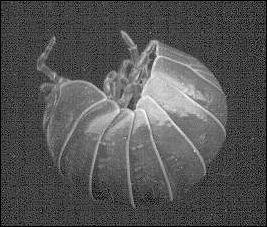
As the desert sun slowly sinks below the horizon, the armored figure stirs and then lurches forward through the tumbled debris. Barely visible in the darkness, its oval, squat body with its overlapping straps of massive armor gives the impression of ominous might. But impressions often are misleading and, despite the armor, this is an entirely inoffensive creature. The purpose of the armor becomes plain when a disturbed animal rolls into a spherical ball, covering all vulnerable parts. Indeed, this protective habit accounts for one of its common names, the pillbug.
Though many people think pillbugs are insects, they actually belong to
the same group as do crabs, shrimp, and lobsters—that's right, they're a
crustacean. More specifically, they belong to a group of crustaceans called isopods.
While most crustaceans are aquatic, a few, such as the land crabs and some of the 4000
species of isopods, are terrestrial. Although widespread through the Chihuahuan Desert,
their gills require a moist microhabitat to function. Deep leaf litter or wood in
protected, moist areas harbor these escapees from the sea. 
Contributor: Arthur H. Harris, Laboratory for Environmental Biology, Centennial Museum, University of Texas at El Paso.
Desert Diary is a joint production of the Centennial Museum and KTEP National Public Radio at the University of Texas at El Paso.


On the left, an underside view, the many legs leaving no doubt that this is not an insect. On the right, the animal is beginning to go into its protective stance.
Center for Insect Science Education Outreach Basic pillbug information and links to lesson plans.